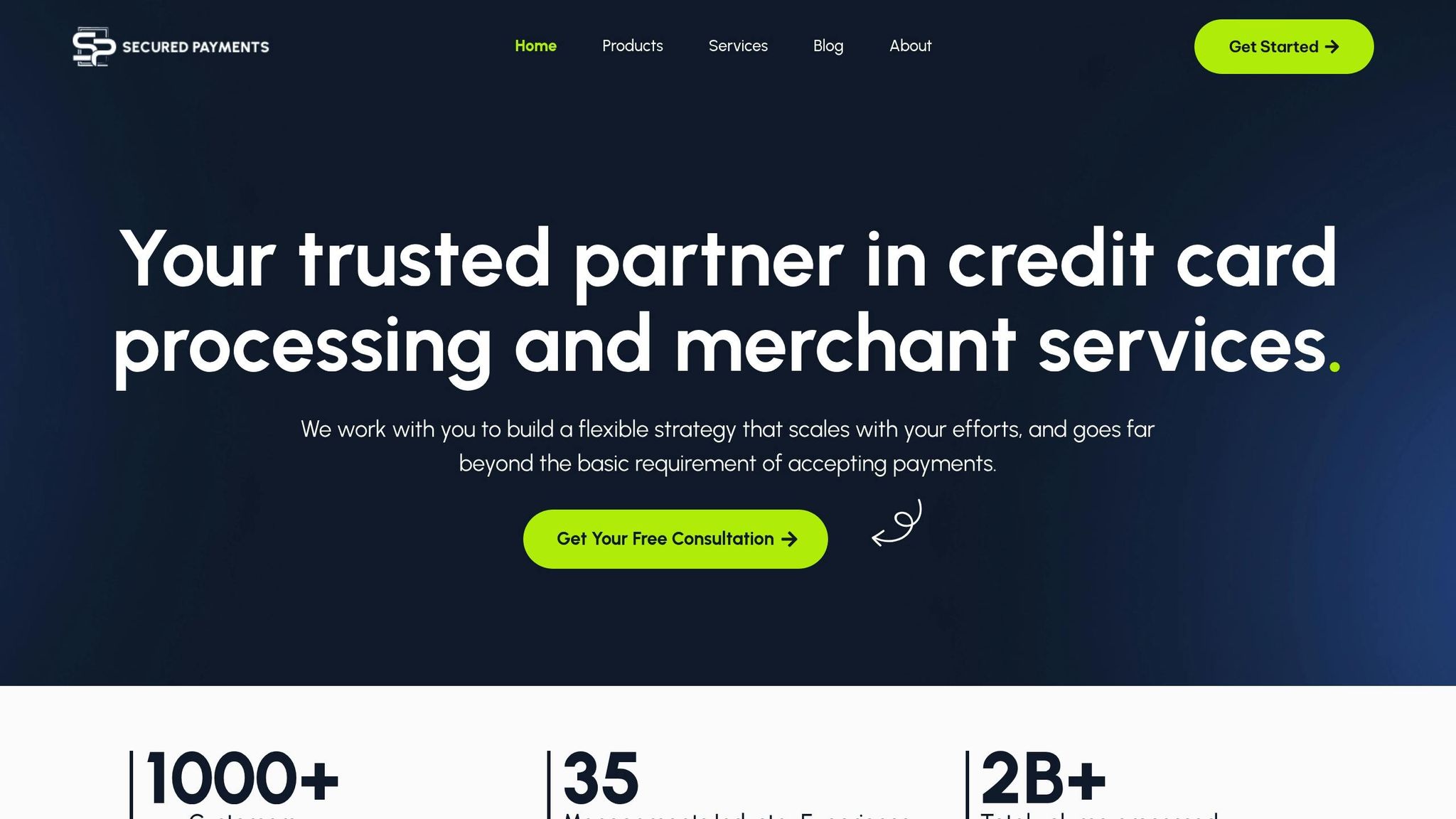High-Risk vs. Low-Risk Merchant Accounts
Merchant accounts enable businesses to accept electronic payments, like credit cards. These accounts are classified as high-risk or low-risk, depending on factors like industry type, fraud potential, and transaction volume. This classification impacts fees, approval processes, and account terms.
Key Differences:
- Low-Risk Accounts: Lower fees (1.5%-3%), minimal restrictions, and faster approvals. Suitable for stable industries like retail and professional services.
- High-Risk Accounts: Higher fees (3.5%-7%), rolling reserves (5%-20%), and stricter terms. Common in industries like travel, CBD, and gambling.
Quick Comparison:
| Feature | High-Risk Accounts | Low-Risk Accounts |
|---|---|---|
| Processing Fees | 3.5%-7% | 1.5%-3% |
| Rolling Reserves | 5%-20% of monthly volume | Rarely required |
| Approval Process | Stringent, requires more documents | Faster, minimal paperwork |
| Monthly Fees | $10-$50 | $0-$20 |
Your business type and risk profile determine which account suits you best, balancing costs and operational needs.
Factors That Determine Risk Classification
When it comes to categorizing businesses as high-risk or low-risk, payment processors rely on several key factors. These criteria influence approval chances, processing fees, and account terms. Understanding these factors can help businesses refine their applications and prepare for potential challenges. Let’s dive into the details.
Industry Type
The type of industry a business operates in plays a major role in determining its risk level. Certain industries are more prone to chargebacks, fraud, or regulatory hurdles, which often leads to a high-risk classification. For instance, adult entertainment businesses face challenges like age restrictions, legal issues, and high chargeback rates. Similarly, industries like travel, tourism, and gambling are flagged due to frequent cancellations, external disruptions, and compliance concerns.
Other industries that typically fall into the high-risk category include:
- Pharmaceuticals and nutraceuticals: Subject to strict regulations and safety concerns.
- Online retail (electronics or jewelry): Higher fraud risks due to the value of goods.
- Tobacco and vaping: Regulatory and health-related scrutiny.
- Telemarketing and telecommunications: Often linked to scams or disputes.
- Cryptocurrency ventures: Unpredictable market conditions and irreversible transactions.
- Legal services (personal injury, bankruptcy): Payment delays and disputes.
- Financial services (loans, debt collection): High default rates.
In contrast, low-risk industries are generally characterized by stable, predictable transaction patterns. Examples include traditional retail stores, professional services like accounting, restaurants, grocery stores, and established brick-and-mortar businesses.
Chargeback Ratios and Fraud History
Chargeback ratios are one of the most critical metrics payment processors evaluate. A chargeback ratio of 1% or higher is often enough to place a business in the high-risk category. Chargebacks can be incredibly costly, with merchants potentially losing up to 2.5 times the disputed amount. On top of that, chargeback fees can range from $20 to $100 per incident.
The global cost of chargeback fraud reached $20 billion in 2023 and is projected to climb to $28.1 billion by 2026. A significant portion of these chargebacks – up to 86% – comes from "friendly fraud", where customers dispute legitimate transactions [9]. Alarmingly, merchants reported a 19% increase in chargeback fraud from 2022 to 2023, and 59% of e-commerce businesses have experienced a rise in online payment fraud.
Here’s a quick look at chargeback rates and risks across industries:
| Industry | Est. Chargeback Rate | Key Risk Factors |
|---|---|---|
| Adult Entertainment | 1% – 3%+ | High dispute frequency, buyer remorse |
| Online Gambling | 1.5% – 3%+ | Unauthorized transactions, legal issues |
| CBD & Cannabis | 1% – 2%+ | Regulatory confusion, delivery disputes |
| Nutraceuticals | 1% – 2.5%+ | Recurring billing, unverified claims |
| Cryptocurrency | 1.5% – 4%+ | Volatility, irreversible transactions |
Transaction Size and Payment Methods
Both transaction size and payment methods heavily influence risk classification. Larger, less frequent transactions are riskier because they can lead to greater financial losses in the event of a chargeback. For example, businesses with an average sale exceeding $50 may be flagged as higher risk. On the other hand, businesses with smaller, more frequent transactions typically face less scrutiny.
Payment methods also play a critical role. Card-not-present transactions – common in online, phone, or mail orders – are inherently riskier than card-present transactions, where security measures like chip readers or signatures can be used. This makes e-commerce businesses particularly vulnerable to fraud due to the remote nature of online payments. Additionally, businesses with inconsistent transaction patterns, seasonal spikes, or international processing are often subject to closer examination, as processors prefer predictable and steady transaction flows.
High-Risk vs. Low-Risk Merchant Accounts: Complete Comparison
Now that we’ve explored what determines a business’s risk classification, let’s dive into how high-risk and low-risk merchant accounts differ in practice. Below, we’ll break down the key operational and financial contrasts between these two account types. These differences make it clear that a business’s risk profile significantly influences the terms of its merchant account.
Benefits and Drawbacks
The table above highlights the major differences, which directly affect how businesses operate under each account type.
High-Risk Merchant Accounts allow businesses that might otherwise struggle to secure payment processing to accept transactions. While these accounts provide a vital service, they come with higher costs. Businesses face elevated processing fees, mandatory rolling reserves, and stricter contract terms. For companies in industries deemed risky, these accounts are often the only option – but the financial strain from higher fees and reserve requirements can be challenging.
Low-Risk Merchant Accounts, on the other hand, are more budget-friendly. They feature lower transaction fees, minimal monthly charges, and access to pricing models like interchange-plus, which can save businesses money. The approval process is relatively simple, requiring only basic credit checks and minimal documentation, which means businesses can start processing payments quickly. These accounts also offer faster transaction times and more flexible contracts. However, businesses must maintain low chargeback rates – typically under 0.5% to 1% – to qualify and keep these favorable terms.
As KORONA POS explains:
Unlike standard merchant accounts, high-risk accounts often come with higher processing fees, rolling reserves, and stricter contract terms to offset the potential liabilities associated with the business.
While high-risk accounts are more expensive, they serve as a lifeline for businesses in industries with greater transaction risks. Low-risk accounts, by contrast, reward businesses with stable operations through better terms and lower fees. The choice between these two account types ultimately depends on a company’s industry, payment needs, and risk profile.
sbb-itb-8c45743
Use Cases and Industry Examples
Building on the earlier discussion about risk factors, real-world examples help illustrate how risk classifications directly influence merchant account requirements. Understanding where a business falls on the risk spectrum can clarify what it needs to operate smoothly.
Low-Risk Business Examples
Low-risk businesses typically operate in stable industries with fewer fraud and chargeback issues. They handle smaller transaction amounts and maintain consistent payment patterns, making them appealing to payment processors.
Take retail stores, for instance. A local clothing boutique processing around $15,000 a month, with individual transactions averaging under $50, fits neatly into the low-risk category. These businesses often benefit from in-person transactions, immediate product delivery, and straightforward return policies, all of which help minimize disputes.
Pet supply stores are another example of low-risk operations. Their simple business models and loyal customer bases contribute to low fraud rates, whether the stores operate online or in physical locations. Regular, repeat purchases further enhance their reliability.
Professional services – like accounting firms, law offices, and consulting businesses – also fall into the low-risk group. These businesses often rely on long-term client relationships, which contribute to their stability. Similarly, parking garages exemplify low-risk operations due to their straightforward payment structures and minimal chances of disputes. Customers pay for clearly defined services that are delivered immediately, reducing the likelihood of chargebacks.
These examples highlight how predictable operations and strong customer relationships create the kind of stability that payment processors favor. On the other hand, industries with higher fraud risks and regulatory complexities are classified as high-risk.
High-Risk Business Examples
High-risk businesses face additional scrutiny due to elevated fraud potential, regulatory hurdles, and higher chargeback rates. These companies often require specialized merchant accounts tailored to their specific challenges.
Travel agencies are a prime example. The industry’s unpredictable nature – such as flight cancellations, booking changes, and service disputes – leads to higher chargeback rates, placing them in the high-risk category.
CBD product sellers also encounter significant hurdles. The legal complexities surrounding cannabis-related products contribute to their classification as high-risk. For instance, CBD businesses often face processing fees as high as 4.5%, compared to the 1.5%–2% range typical for retail businesses.This fee disparity reflects the regulatory uncertainties and banking restrictions tied to the CBD market.
Subscription services are another high-risk category. Their recurring billing models can lead to disputes when customers forget about automatic renewals or struggle to cancel subscriptions. Similarly, forex trading platforms are considered high-risk due to the volatile nature of currency markets and the potential for significant financial losses. Credit repair services also face high-risk classification because of regulatory scrutiny and the challenges involved in delivering promised outcomes.
These examples underscore why risk classification is so important. For instance, while a pet supply store might pay processing fees around 1.5% per transaction with minimal documentation requirements, a CBD retailer could face fees as high as 4.5%, along with rolling reserves of 5% to 10% of their monthly volume [7][12]. These differences highlight the need for tailored merchant services – something Secured Payments specializes in providing for both high- and low-risk businesses.
How Secured Payments Supports All Merchant Account Types

Secured Payments understands that high-risk and low-risk businesses face different challenges when it comes to payment processing. That’s why it offers tailored solutions to meet the unique needs of each category, whether it’s a CBD retailer or a local pet supply store. Let’s break down how Secured Payments provides specialized tools and expert guidance for both high-risk and low-risk merchants.
Custom Solutions for High-Risk Businesses
High-risk businesses often deal with higher fraud risks and chargeback rates, which can make payment processing more complicated. Secured Payments steps in with solutions specifically designed to tackle these challenges head-on.
For starters, their advanced fraud prevention tools use real-time monitoring to detect and flag suspicious transactions before they escalate into costly problems. On top of that, chargeback management tools help businesses stay ahead of potential disputes. With early alerts, merchants can address issues proactively, sometimes turning chargebacks into refunds and reducing financial losses. To keep everything on track, enhanced reporting functions allow businesses to monitor transactions and defense strategies in real time.
For companies handling international payments or complex transaction flows, Secured Payments offers dynamic routing. This technology ensures transactions are processed through the best channels, improving approval rates without compromising security.
Secured Payments also advocates for high-risk businesses by securing favorable terms, such as fixed bonds, rolling reserves, and deferred payments. These measures ensure that even businesses in high-risk industries can access reliable payment processing services.
Flexible Options for Low-Risk Businesses
Low-risk merchants, with their more stable profiles, benefit from cost-effective and straightforward payment processing options. Secured Payments leverages their lower risk to provide better processing fees, faster approvals, and more favorable contract terms.
Low-risk businesses can access a variety of payment solutions, including integrated POS systems for brick-and-mortar stores, e-commerce gateways for online sales, and invoicing tools for service-based operations. This flexibility allows merchants to choose the payment methods that best align with their business model and customer preferences.
One standout advantage for low-risk businesses is improved cash flow. Unlike high-risk merchants who may face restrictions like rolling reserves, low-risk businesses often enjoy same-day or next-day access to funds. This steady cash flow enables them to maintain smooth operations and invest in growth initiatives.
Additionally, Secured Payments ensures pricing remains clear and competitive for low-risk clients. Transparent pricing structures help businesses manage costs effectively while supporting their bottom line.
Consulting and Expert Support
Secured Payments doesn’t just stop at technology – it also provides expert consulting services to help businesses refine their payment strategies and navigate operational challenges. This guidance is especially valuable for companies facing complex regulations or planning expansions into new markets.
The consulting team works closely with merchants to identify the best payment platforms for their needs, whether they’re launching an e-commerce store, expanding internationally, or transitioning between risk classifications. These strategic insights can lead to lower processing costs and improved efficiency.
Compliance is another key area where Secured Payments provides support. By helping businesses meet regulatory requirements from the outset, the team minimizes the risk of disruptions or penalties, which is especially critical for industries with strict regulations.
To ensure smooth operations, Secured Payments offers 24/7 customer support. Whether it’s resolving technical issues, answering questions, or providing ongoing advice, this round-the-clock assistance ensures that merchants can focus on running their businesses without being derailed by payment processing problems.
Lastly, Secured Payments helps businesses reduce risks and costs by optimizing transaction routing and fine-tuning payment methods. This proactive approach not only saves money but also ensures regulatory compliance, keeping operations running smoothly.
Conclusion
Grasping the differences between high-risk and low-risk merchant accounts is essential for smooth payment processing. These account types influence everything from fees and terms to approvals and cash flow management.
For instance, businesses with a chargeback ratio of 1% or higher are often classified as high-risk. On the other hand, companies with average transaction amounts under $50 and monthly sales capped at $20,000 usually fall into the low-risk category.
Both account types play distinct roles in the payment ecosystem. Low-risk accounts are ideal for businesses with steady, predictable transactions, offering lower fees, quicker approvals, and fewer limitations. High-risk accounts, while more expensive, provide critical features like stronger fraud protection and support for international transactions – essential for industries like CBD retail or online gaming. These differences help businesses choose the account type that best suits their needs.
For example, a CBD retailer or an online gaming platform may rely on the specialized tools and higher risk tolerance of high-risk processing. In contrast, a local pet supply store can enjoy the simplicity and cost savings of low-risk processing. Regardless of your category, working with a payment processor that understands your specific challenges is key.
Choosing the right merchant account goes beyond just accepting payments – it’s about balancing costs, mitigating risks, and fueling your business growth effectively. Matching your risk profile to the right account ensures streamlined payment processing and sets the stage for sustainable success.
FAQs
What should businesses consider when choosing between high-risk and low-risk merchant accounts?
When choosing between a high-risk and low-risk merchant account, businesses should take a close look at factors like their industry, transaction volume, chargeback rates, and how well they adhere to relevant regulations.
High-risk merchant accounts cater to industries such as travel, online gaming, or subscription services – sectors known for higher chargeback rates or increased regulatory oversight. These accounts often come with steeper fees, tighter terms, and added security measures to help manage potential risks.
In contrast, low-risk merchant accounts are a better fit for businesses in stable industries like retail or professional services. They typically feature lower fees, easier approval processes, and more favorable contract terms, making them a good choice for businesses with solid financial records and minimal chargebacks.
Take the time to evaluate your business’s specific needs and risk level to decide which account type is the best match for your operations.
What can businesses in high-risk industries do to manage higher fees and rolling reserves on their merchant accounts?
Businesses operating in high-risk industries often face challenges like higher fees and rolling reserves. However, these hurdles can be managed with a few smart strategies. Start by focusing on reducing chargebacks through tools like the Address Verification Service (AVS) and Card Verification Value (CVV2). These fraud prevention measures can help ensure transactions are legitimate. On top of that, offering exceptional customer service and setting up clear refund policies can go a long way in minimizing disputes and keeping customers happy.
Another key step is negotiating reserve rates with your payment processor. These reserves typically fall between 5% and 15%, but building a strong, transparent relationship with your processor might help you secure better terms. By combining these efforts, businesses can alleviate some of the financial strain tied to high-risk merchant accounts and keep payment operations running more smoothly.
How can low-risk businesses maintain their classification and continue enjoying lower fees and faster approvals?
To keep a low-risk classification – and all the perks that come with it – businesses need to prioritize keeping their chargeback ratios low (ideally under 1%). This means offering clear and accurate product descriptions, being upfront about billing practices, and delivering top-notch customer service.
On top of that, it’s smart to regularly update security measures and rely on advanced fraud prevention tools to minimize risks. A solid financial track record and strict adherence to industry compliance standards are just as important. By keeping an eye on processing limits and quickly addressing any red flags, businesses can maintain their low-risk status and continue enjoying its benefits.




